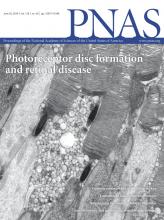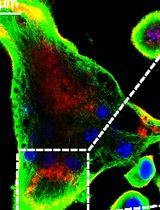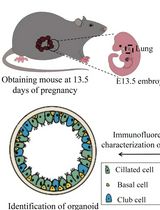- EN - English
- CN - 中文
RNA Interactome Identification via RNA-BioID in Mouse Embryonic Fibroblasts
利用 RNA-BioID鉴定小鼠胚胎成纤维细胞中RNA相互作用体
发布: 2020年01月05日第10卷第1期 DOI: 10.21769/BioProtoc.3476 浏览次数: 5400
评审: Imre GáspárOlga SinSwati MeghaFernando A Gonzales-Zubiate
Abstract
Cytoplasmic localization of mRNAs is common to all organisms and serves the spatial expression of genes. Cis-acting RNA signals (mostly found in the mRNA’s 3'-UTR), called zipcodes recruit trans-acting RNA-binding proteins that facilitate the localization of the mRNA. UV-cross-linking or affinity purification has been applied to identify such proteins but suffer from the need for stable RNA-protein binding or direct contact of protein and RNA. To identify stably or transiently interacting proteins that directly or indirectly associated with the localization elements and the body of the mRNA, we developed an in vivo proximity labeling method we call RNA-BioID. In RNA-BioID, we tether a fusion of the BirA* biotin ligase and the MS2 coat protein (MCP) at the 3'-UTR of MS2-tagged β-actin mRNA in vivo. Exposing BirA* expressing cells to biotin in the media and induces biotinylation of β-actin mRNA-associated proteins that can be isolated with streptavidin beads. This technique allowed us to identify by mass spectrometry analysis the β-actin mRNA 3'-UTR-interacting proteome in fibroblasts. The protocol can be useful to identify the interacting proteome of any mRNA in mammalian cells.
Keywords: RNA-BioID (RNA-BioID)Background
Localization of mRNAs to specific subcellular sites is a widespread phenomenon and has been observed from bacteria to humans (Bovaird et al., 2018; Fei and Sharma, 2018). Diverse human pathologies of the neural system are linked to defects in mRNA localization (Tolino et al., 2012; Bovaird et al., 2018). Additionally, this mechanism is essential for developmental processes including mesoderm formation in the clawfrog Xenopus laevis or the determination of the embryonic body axes of the fruit fly Drosophila melanogaster (Jansen, 2001). To achieve intracellular asymmetry of transcripts, mRNAs are incorporated into motor-protein containing particles that can move along the cytoskeleton to distinct cellular sites, where the transcripts are locally translated (Marchand et al., 2012; Buxbaum et al., 2015). Such particles containing mRNA and RNA-binding proteins (RBPs) are beginning to assemble during transcription and undergo several changes upon maturation in the cytoplasm (Holt et al., 2019). Localized mRNAs differ from non-localized ones by containing cis-acting motifs termed localization elements or zip codes that are recognized by specific RBPs (Bovaird et al., 2018). Zipcodes can be positioned in the coding sequence but are mainly found in the 3' untranslated region (3'-UTR; Bovaird et al., 2018).
A well-studied example is the 54-nt long zip code in the 3'-UTR of β-actin mRNA that is essential for targeting the mRNA to the leading edge of fibroblasts as well as to growth cones and dendrites in neurons (Ross et al., 1997; Eom et al., 2003; Buxbaum et al., 2015). The zip code is recognized by the RBP ZBP1 (aka IGF1 or IGF2BP1) that is not only essential for the localization of β-actin mRNA (Ross et al., 1997; Oleynikov and Singer, 2003) but also represses the translation of the mRNA until it has arrived at the target site (Hüttelmaier et al., 2005). However, additional RBPs and supplementary factors are involved in splicing, translational regulation, stabilization, transport, and decay of β-actin mRNA.
Obtaining a complete set of the proteins that associate with any mRNA remains challenging, despite a large range of high-throughput methods available so far that include diverse pulldown approaches as well as cross-linking and immunoprecipitation (CLIP) (for an overview see Ramanathan et al., 2019). A specific challenge that remains is the identification of transient interactors that are not directly contacting the RNA. To solve this, we recently introduced a proximity biotinylation method-based on tethering the BioID biotin ligase BirA (BirA*) via MS2 coat binding protein (MCP) at the 3'-UTR of MS2-tagged β-actin mRNA (Park et al., 2014). In the presence of biotin, BirA* generates AMP-biotin (‘activated biotin’), which reacts with accessible lysine residues in its vicinity (10-20 nm). After lysis, biotinylated proteins can be isolated via streptavidin affinity purification and identified using standard mass spectrometry techniques. The RNA-BioID method can in principle be applied to any MS2-tagged mRNA and allows the identification of its associated proteins as well as probing its environment by indirect or transient interactions.
Materials and Reagents
- Beaker (500 ml, 1 L)
- 50 ml conical tube
- 21 G needle
- T175 flasks (Corning, catalog number: CLS431080)
- 10 cm culture dishes (Corning, catalog number: 430167)
- 6-well dishes (Corning, catalog number: CLS3516)
- FACS tubes (Falcon, catalog number: 352235)
- Reprosil-Pur C18-AQ, 1.9 μm resin (Dr. Maisch GmbH)
- 25 cm fused silica emitters with an inner diameter of 75 μm (DNU-MS GbR)
- Bench cleaner (terralin® PAA, catalog number: 126203, store at room temperature)
- 1.5 ml safe seal pyrogen-free tubes (Sarstedt, catalog number: 72.706.201)
- 0.45 μm filter (Sartorius, catalog number: 10109180)
- pH strip 0.0-6.0; 6.0-10.0 (MN, Part No: 1138922; 1178895)
- PVDF membrane (GE Healthcare AmershamTM HybondTM-P Membranes, catalog number:10471085, store at room temperature)
- Phage-ubc-nls-2xmcp-egfp-BirA* (Addgene Plasmid, catalog number: 131132) or phage-ubc-nls-2xmcp-egfp-cMyc BirA* (Addgene Plasmid, catalog number: 131133) or phage-ubc-nls-2xmcp-mCherry-BirA* (Addgene Plasmid, catalog number: 131136)
- pCEP4-tat (Addgene Plasmid, catalog number: 22502)
- pRSV-Rev (Addgene Plasmid, catalog number: 12253)
- pMDLg/pRRE (Addgene Plasmid, catalog number: 12251)
- pMD2.G (Addgene Plasmid, catalog number: 12259)
- Hek293 FT cells (Thermo Scientific, catalog number: R70007)
- Wildtype mouse embryonic fibroblasts (MEFs, e.g., Park et al., 2014)
- Magnetic sepharose streptavidin Beads (GE, catalog number: 28985799, store at 4 °C)
- MBS MEFs (MEFs with 24 MS2 binding sites (MBS) inserted in the 3’-UTR of β-actin gene loci; see Park et al., 2014)
- Fugene 6 (Promega, catalog number: E2691, store at 4 °C)
- Trypsin (Sigma-Aldrich, catalog number: T4049, store at -20 °C)
- Fetal calf serum (FBS; Sigma-Aldrich, catalog number: F4135, store at -20 °C)
- Alkaline phosphatase-conjugated streptavidin
- Trypsin, sequencing grade, modified, 0.5 μg/μl (Promega, catalog number: V5113)
- LentiX concentrator (Takara, catalog number: 631231, store at 4 °C)
- Lysyl endopeptidase Lys-C (Waco, catalog number: 129-02541), stocks: 0.5 μg/μl in H2O
- OptiMEM (Thermo scientific, catalog number: 31985062, store at 4 °C)
- DMEM high glucose media (Sigma-Aldrich, catalog number: D6429, store at 4 °C)
- 1x PBS (Sigma-Aldrich, catalog number: D6429, store at 4 °C)
- Penicillin-Streptomycin solution (Sigma-Aldrich, catalog number: P4333, store at -20 °C)
- Bleach powder (Schülke perform® disinfectant, catalog number: 107912, store at room temperature)
- Hand disinfectant (STERILLIUM Virugard solution, catalog number: 126064, store at room temperature)
- Biotin (Sigma-Aldrich, catalog number: B4501, store at 4 °C)
- Complete protease inhibitor, EDTA free (Roche, catalog number: 11697498001, store at 4 °C)
- 5x Roti Quant Bradford reagent (Roth, catalog number: K015.3, store at 4 °C)
- SDS (sodium dodecyl sulfate) (Roth, catalog number: CN30.1, store at room temperature)
- Bromophenol blue (Roth, catalog number: A512.1, store at room temperature)
- Glycerol (Sigma-Aldrich, catalog number: G6279, store at room temperature)
- Nu-PAGE SDS-PAGE gel 4-12% (Invitrogen, catalog number: WG1402BOX, store at 4 °C)
- NuPAGE MOPS SDS Running Buffer (20x) (Invitrogen, catalog number: NP0001, store at 4 °C)
- β-mercaptoethanol (Roth, catalog number: 42273, store at room temperature)
- p-Nitrotetrazoliumblauchlorid (NBT) (Roth, catalog number: 4421.2, store at -20 °C)
- 5-Bromo-4-chloro-3-indolyl-phosphate Disodium Salt (BCIP) (Roth, catalog number: A155.2, store at -20 °C)
- Ammonium Bicarbonate (Sigma-Aldrich, catalog number: 09830, store at room temperature)
- NuPage SDS-PAGE gels (Thermo scientific, catalog number: NP0315BOX, store at 4 °C)
- PHOENIX Peptide Cleanup Kit (PreOmics, catalog number: P.O.00023)
- Dithiothreitol (VWR, catalog number: 0281-5G, store at room temperature)
- Urea (Merck, catalog number: 1.08488.1000, store at room temperature)
- Thiourea (Merck, catalog number: 1.07979.0250, store at room temperature)
- Iodoacetamide (Merck, catalog number: 8.04744.0025, store at room temperature)
- Acetonitrile (Merck, catalog number: 1.00030.2500)
- Formic acid (Sigma-Aldrich, catalog number: 33015-500ML)
- Acetic acid (Roth, catalog number: 3738.5)
- Trifluoracetic acid (TFA) (Merck, catalog number: 1.08262.0100)
- NaCl
- MgCl2
- Tris-Cl
- TBS
- Tween 20
- Deoxycholate
- HEPES
- EDTA
- LiCl
- Complete media (500 ml) (see Recipes)
- Serum-free media (100 ml) (see Recipes)
- Biotin Media (100 ml) (see Recipes)
- 50 mM Biotin solution (see Recipes)
- BCIP (5-bromo-4-chloro-3-indolyl phosphate) (see Recipes)
- NBT (Nitro blue tetrazolium) (see Recipes)
- AP (Alkaline phosphatase) substrate buffer (see Recipes)
- 1x TBS (Tris-buffered saline) (see Recipes)
- 1x TBST (Tris-buffered saline-Tween) (see Recipes)
- Lysis Buffer (see Recipes)
- Wash Buffer 1 (see Recipes)
- Wash Buffer 2 (see Recipes)
- Wash Buffer 3 (see Recipes)
- Wash Buffer 4 (see Recipes)
- 20 mM ABC (Ammonium bicarbonate) buffer (see Recipes)
- 2x SDS (Sodium dodecyl sulfate) sample buffer (see Recipes)
- Denaturation buffer (see Recipes)
- Reduction buffer (see Recipes)
- Alkylation buffer (see Recipes)
- Solvent A* (see Recipes)
- Solvent A (see Recipes)
- HPLC solvent A (see Recipes)
- HPLC solvent B (see Recipes)
Equipment
- 37 °C water bath (Fisher Scientific, Isotemp 205 Water Bath)
- Cell culture incubator, set to 5% CO2 (Thermo Scientific, HeracellTM 150i CO2 Incubators)
- Centrifuge (Eppendorf, model: 5430)
- Cell sorter (BD, model: FACS Aria I)
- End-to-end rotator (Heidolph, model: REAX 2)
- Thermomixer (Eppendorf, catalog number: 5350 000.013)
- Magnetic stand (Bio-Rad, catalog number: 1614916)
- Centrifuge (Heraeus Fresco 17, Thermo Fisher Scientific, catalog number: 75002420)
- Western blot SDS-PAGE running apparatus (Bio-Rad, Mini Trans-Blot® Cell)
- Western blot SDS-PAGE wet transfer apparatus (Bio-Rad, Mini Trans-Blot Module, catalog number: 1703935)
- Concentrator plus vacuum centrifuge (Eppendorf, catalog number: 5305 000.304)
- EASY-nLC 1200 (Thermo Fisher Scientific) or any (U) HPLC system compatible with the MS system of choice
- LTQ Orbitrap or Q Exactive mass spectrometer (Thermo Fisher Scientific) or any state-of-the-art high-resolution mass spectrometer.
- Fluorescence microscope (Zeiss CellObserver, 40x, 1.4 NA oil immersion objective, GFP filterset 38HE)
Software
- MaxQuant software suite (www.maxquant.org, Max-Planck-Institute of Biochemistry, Martinsried), or other programs that can be used for downstream analysis
- Perseus (http://www.coxdocs.org/doku.php?id=perseus:common:download_and_installation, Max-Planck-Institute of Biochemistry, Martinsried)
Procedure
文章信息
版权信息
© 2020 The Authors; exclusive licensee Bio-protocol LLC.
如何引用
Mukherjee, J., Franz-Wachtel, M., Maček, B. and Jansen, R. (2020). RNA Interactome Identification via RNA-BioID in Mouse Embryonic Fibroblasts. Bio-protocol 10(1): e3476. DOI: 10.21769/BioProtoc.3476.
分类
发育生物学 > 细胞生长和命运决定 > 分化
分子生物学 > RNA > RNA 检测
您对这篇实验方法有问题吗?
在此处发布您的问题,我们将邀请本文作者来回答。同时,我们会将您的问题发布到Bio-protocol Exchange,以便寻求社区成员的帮助。
提问指南
+ 问题描述
写下详细的问题描述,包括所有有助于他人回答您问题的信息(例如实验过程、条件和相关图像等)。
Share
Bluesky
X
Copy link













